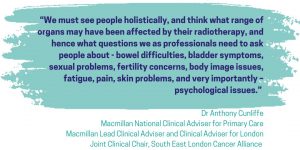Access the Pelvic Radiation Disease (PRD) Best Practice Pathway
*please note that the link to PRD GI Guidance is broken on the document please find the correct link here:
The Practical Management of the Gastrointestinal Symptoms of Pelvic Radiation Disease.
Development of the Pelvic Radiation Disease Best Practice Pathway
Since 2019 the Pelvic Radiation Disease Association has been working with leading UK experts in late effects of pelvic radiotherapy to produce the first ever Pelvic Radiation Disease (PRD) Best Practice Pathway. This ground-breaking publication was launched at our Annual Conference to an audience of healthcare professionals and people affected by PRD.
What is the Best Practice Pathway, and why is it important?
The Best Practice Pathway addresses the lack of awareness about the impact Pelvic Radiation Disease (PRD) has on people’s lives, and the lack of knowledge about how to improve symptoms and quality of life.

The Best Practice Pathway will support healthcare professionals to address the holistic needs of people affected by long-term side effects of pelvic radiotherapy. The document will help to develop high quality, multi-disciplinary, person-centred pathways of care.
 Each chapter covers key clinical management steps, and points users to published guidance, service models, quality standards and sources of professional education. There is also a comprehensive section on supporting people to self-manage their PRD symptoms.
Each chapter covers key clinical management steps, and points users to published guidance, service models, quality standards and sources of professional education. There is also a comprehensive section on supporting people to self-manage their PRD symptoms.
The document is aimed at any healthcare professional who cares for someone with PRD. It is also an opportunity for people living with PRD to better understand their current care options and how to advocate for better care for themselves.
We want the Best Practice Pathway to continue to raise awareness of the devastating impact of PRD on people’s lives, the range of symptoms and problems it can cause, and the many effective, and often poorly-understood, ways to manage them.
Modified: 21st February 2024

